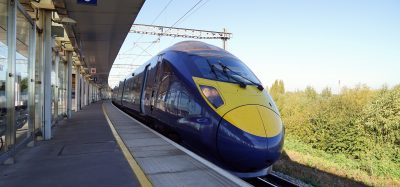JIT: delivery is key
Posted: 23 August 2005 | | No comments yet
The eyes of the railway world are on France as it builds the latest addition to its successful high speed network – the TGV Est line that will link Paris with eastern France and beyond. The €3 billion first phase of the programme, which commenced in spring 2002, is placing heavy demands on civil engineers and railway infrastructure suppliers working to tight schedules to ensure the network opens in 2007.
The eyes of the railway world are on France as it builds the latest addition to its successful high speed network – the TGV Est line that will link Paris with eastern France and beyond. The €3 billion first phase of the programme, which commenced in spring 2002, is placing heavy demands on civil engineers and railway infrastructure suppliers working to tight schedules to ensure the network opens in 2007.
The eyes of the railway world are on France as it builds the latest addition to its successful high speed network – the TGV Est line that will link Paris with eastern France and beyond. The €3 billion first phase of the programme, which commenced in spring 2002, is placing heavy demands on civil engineers and railway infrastructure suppliers working to tight schedules to ensure the network opens in 2007.
The entire rail for the project is being supplied by Corus. In this article, three of the company’s senior executives explain how Corus is meeting the technical and logistic challenges posed by TGV Est.
During the summer of 2005, rail production for the high profile TGV Est project in France is reaching its peak. In the month of June alone, the Corus rail mill at Hayange in the Fensch Valley rolled 11,000 tonnes of rail for the first phase of the programme. By early next year, Corus will have supplied more than 86,000 tonnes of new rail to its customer, Société Nationale des Chemins de fer Français (SNCF).
The high volume of rail required for TGV Est (the Eastern France European High Speed Railway), together with strict requirements for ‘just-in-time’ (JIT) delivery and an exacting technical specification, pose several challenges for Corus. Corus is meeting those challenges by leveraging its considerable experience in high speed rail production and capitalising on recent investment in production and testing technology.
Since rail deliveries for TGV Est began at the end of last year, Corus has achieved a 100 per cent record in on-time delivery. The importance of performance on such a prestigious programme is not lost on Corus’ man responsible for international sales, Commercial Director, Hubert Dabas.
“There is a high regard globally for railways in France, and involvement in this project provides us with a very good shop window from a commercial point of view. It is obviously important that we perform well and manage the programme very efficiently.
Because of the high volumes involved and the just-in-time deliveries, we have had to work very closely with SNCF. We meet with them regularly and they give us three-monthly forecasts for required rail and then these are translated into firm commitments eight weeks ahead of the delivery date.
It has meant close attention to detail in terms of scheduling production at our mill. We have other customer commitments – for export rail and for maintenance programmes in France – so our production programme needs close monitoring in order to meet all of our contracted deliveries. We have also worked hard to make our supply chain as efficient as possible.”
For the TGV Est programme, the Hayange mill uses steel bloom supplied largely by Corus at Scunthorpe in the UK where a multi-million pound investment programme was launched recently. The high quality bloom from Scunthorpe meets stringent chemistry and steel cleanliness requirements.
Continuing investment at Hayange has also ensured consistent product quality and helped Corus to achieve the position of top rail supplier in Europe – by volume – in 2004. Corus has to date supplied the entire rail for France’s high speed networks and, in the 1990s, it invested heavily at Hayange in order to increase the length of its high speed rail. The investment included the installation of longer rail cooling tables and the construction of a new finishing area for the longer rails.
Utilising technology
The Hayange mill, which produces rail using the universal rail rolling process developed there and now used under licence around the world, also incorporates a range of technology for rail straightening and non-destructive testing. As Managing Director, Corus – Rail Sector, Gérard Glas, explains: “Our biggest technical challenge in supplying rail for TGV Est is achieving the straightness required. Because of the high speed of the trains we have to avoid vibration in order to achieve passenger comfort and ensure track life. Excessive dynamic loads would mean damage to wheels, suspension and track and necessitate more track maintenance.
In the 1980s we designed a vertical plane straightener for use with high speed rail and introduced sophisticated measurement devices for checking straightness. We have since supplemented these facilities and perfected a process of continuous inspection of straightness so that we can detect the slightest undulations within a range of wavelengths from 0.3 metres to 3.5 metres. Our ‘wavemeter’ measuring instrument consists of a rigid beam carrying four distance sensors in each horizontal and vertical plane. Processing the signals makes it possible to simulate the passage of a straight edge on the rail in the two planes and to check the rails automatically.”
To date, Corus has produced around 350,000 tonnes of high speed rail for customers around the world, including an order for a prototype track in China. As a result of its expertise developed in high speed rail from the 1970s onwards, Corus was involved in drafting the European standard for high speed rail. The strict tolerances regarding straightness of the rail are 0.3mm over a three metre length and 0.2mm over a two metre length with particular attention being paid to the quality of the finish on the rail ends.
The 60E1 grade rail produced by Hayange for SNCF (in 80 metre lengths and to a minimum 260 HB) undergoes a battery of non-destructive testing. In 2003 – in preparation for an anticipated contract for TGV Est rail – Corus upgraded its ultra-sonic inspection line at Hayange where rail is checked for inclusions (non-metallic clusters that can act as stress initiators beyond a critical size). Visual inspection and Eddy Current testing for surface defects are also utilised to ensure product quality.
The rail produced by Corus is guaranteed for five years from the end of the year of manufacture, but Corus is confident that its in-track life will extend far beyond that. Gérard Glas says: “The rails we supplied for the Paris to Lyon high-speed network are still in use after a gross tonnage of around 25-30 million tonnes a year. I believe phase one of TGV Est is anticipated to carry traffic of around 20-25 million tonnes a year. I would see the high speed track being used for at least 25 years because of the quality of our product and the maintenance policy of SNCF.”
Corus has worked closely with SNCF for many years and must liaise with its customer on a daily basis to ensure success with TGV Est. Unusually, SNCF had to compete for the high speed contract placed by Réseau Ferré de France (RFF). Corus worked with SNCF to assemble the successful bid for rail supply and has since had a dedicated team – comprising commercial, technical and logistics professionals – working on the programme.
Meeting the JIT challenge
Apart from the strict technical specification, it is the delivery requirement in the contract that produces one of the biggest challenges for Corus. Corus is contracted to supply its 80 metre lengths of rail for welding into 400 metre strings at the SNCF Saulon welding shop. Corus’ Supply Chain Manager, Peter Smith, explains: “SNCF has chosen to operate with as lean a supply chain as possible and adopted a policy of not holding stock in front of the welders. This just-in-time approach means that all of our mill production is currently scheduled around our TGV commitments – we position SNCF’s requirement first and fit our other business around it. And although our rail is sold ex-works, we have to work very closely with SNCF to ensure that the delivery arrangements are working. This means contact on a daily basis so that together we are always in a position to foresee and resolve any difficulties. We have leveraged our long-term relationship with SNCF to meet their requirements and there is a good level of co-operation and understanding between us.”
The rail rolling and finishing process at Hayange is fast. To avoid inefficient double-handling of finished rail, Corus plan its production meticulously and ensure that empty rail wagons are ready to receive the high speed rail, collected from the mill at Hayange by SNCF’s own specially adapted transport fleet and transported to its welding shop at Saulon near Dijon.
Peter Smith has a team of production schedulers working at the Hayange mill capable of rolling up to 2000 tonnes of rail per day on a system of 13.5 shifts per week. Rail for TGV Est made up around 30 per cent of the mill’s output in June. Altogether, the deliveries to SNCF during the summer of 2005 have increased by around 75 per cent to accommodate the TGV requirement.
“This is a high volume project – the biggest single rail project in Europe this year,” said Peter Smith, adding, “The just-in-time element is a challenge for us, but we have a good track record in supplying customised solutions for customers. We can accommodate considerable flexibility at the mill and we have extensive experience in the transport and logistic arrangements that are necessary to make a programme like this successful.”
Co-ordinating material supply
Meticulous planning of rail production at Hayange is mirrored in the process for procuring raw material from the UK. Peter Smith and his team liaise closely with Corus at Scunthorpe where, recently, a dedicated dispatch area has been installed for bloom, bound for Hayange. Bloom dispatch is matched to the finished TGV rail delivery requirements.
To ensure a constant and adequate supply of bloom to meet the TGV rail programme, Peter Smith and his team have refined their transport process and are again working closely with EWS and SNCF to utilise their rail freight arrangements.
“We’re exploiting their freight routes through the Channel Tunnel,” says Peter Smith, “and we use six trains per week with an average load of 900 tonnes. We also use top-up road transport and vessels from the north-east coast of England over to mainland Europe where the bloom can then go by rail or barge on the Rhine or Moselle. But the tunnel is the most efficient route, with a 24-hour transit time.”
With time built in for loading the bloom, it means the raw material can be at the Hayange mill just 48 hours after finishing its process of slow cooling at Scunthorpe. The bloom can be in the holding bay at Hayange for a week or as little as a day before it is rolled.
Corus expects to complete its deliveries for Phase One of TGV Est in March 2006, by which time it will have delivered more than 1,200km of rail. This first phase of the network – from Vaires-sur-Marne near Paris to Baudrecourt in Moselle – will open in 2007, whereupon commercial trains will run on the line at speeds of 320km/hour, although the track will in fact have a potential operating speed of 350km/hour. The next phase of the TGV Est programme will extend the network further east to Strasbourg – opening up high speed travel to thousands of new customers and slashing journey times from Paris to Strasbourg to two hours 15 minutes.
Gérard Glas: “It is unclear when phase two will start – there are currently talks over the finance arrangements. But I think the completion and opening of Phase One will encourage everyone to move on with the project and open up the link with the east of the country and the rest of Europe. Winning Phase Two will of course be a competitive process, but I am confident that our performance on Phase One will stand Corus in good stead for again playing a key role in the further development of high speed rail travel in Europe.”






